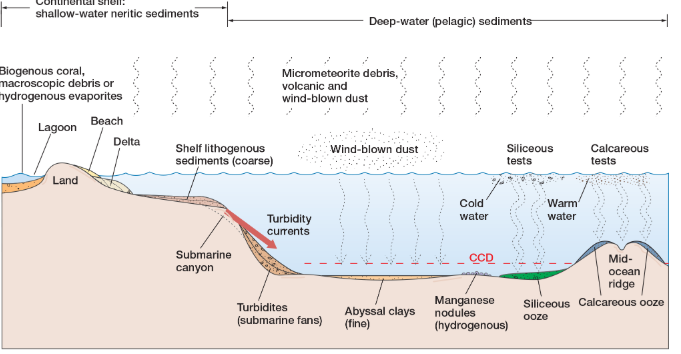4.6 How are pelagic and neritic deposits distributed?
1/15
There's no tags or description
Looks like no tags are added yet.
Name | Mastery | Learn | Test | Matching | Spaced |
|---|
No study sessions yet.
16 Terms
lithogenous and biogenous sediment rarely occur as absolutely pure deposits that don’t contain other types of sediment, resulting in:
most marine sediments occurring as mixtures
in order to classify marine sediment according to a single type, oceanographers note the following characteristics about sediments:
abundance of clay-sized lithogenous particles throughout the world and the ease w/ which they’re transported by winds and currents means these particles are incorporated into every sediment type
most lithogenous sediment contains small percentages of biogenous particles
composition of bigenous ooze includes up to 70% fine-grained lithogenous clays
most calcareous oozes contain some siliceous material and vice versa
there are many types of hydrogenous sediment
tiny amounts of cosmogenous sediment are mixed in w/ all other sediment types
although sediment deposits on the sea floor are usually a mixture of different sediment types, typically one type of sediment dominates:
allows deposit to be classified as primarily lithogenous, biogenous, hydrogenous, or cosmogenous

neritic deposits
near shore deposits, covering about ¼ of ocean floor
coarse-grained lithogenous neritic deposits dominate continental margin areas bc lithogenous sediment is derived from nearby continents
mainly lithogenous, sometimes bigenous, hydrogenous, cosmogenous, but very little
pelagic deposits
deep-ocean basin, cover other ¾ of ocean
dominated by biogenous calcareous oozes, found on relatively shallow deep-ocean areas along MOR
biogenous siliceous oozes found beneath areas of unusually high biological productivity
fine lithogenous pelagic deposits of abyssal clays are common in deeper areas of ocean basins
hydrogenous and cosmogenous comprise only a small portion of pelagic deposits in the ocean
most dominant sediments worldwide
calcareous ooze (45% of deep ocean floor)
decreases in deeper ocean basins bc they generally lie beneath the CCD
abyssal clay (38%)
siliceous ooze (8%)
dominant oceanic sediment in deepest basin
abyssal clay
most widely deposited sediment in shallower areas
calcareous ooze
why do siliceous oozes cover a smaller percentage of ocean floor
regions of high productivity of organisms that produce silica tests are generally restricted to the equatorial region (radiolarians) and high latitudes (diatoms)
average rates of sedimentation rate of selected marine sediments
coarse lithogenous sediment, neritic deposit: 1m/1000y
biogenous ooze (pelagic): 1cm/1000y
abyssal clay (pelagic): 1mm/1000y
manganese nodule (pelagic): 0.001mm/1000y
why do biogenous tests on deep-ocean floor closely reflect population of organisms living in surface water directly above, even though it takes 10-50 yrs for the tests to sink to the abyssal depths?
99% of particles that fall to the ocean floor do so as part of fecal pellets, which are produced by tiny animals that eat algae and protozoans living in the water column, digest their tissues, and excrete their hard parts, and sink to ocean floor in only 10-15 days
where do areas of thick sediment accumulation occur?
on cont. shelves, rises, and near mouths of major rivers bc they are close to major sources of lithogenous sedimentswhe
where do areas of thin sedimentation occur?
thinnest where ocean floor is young, along crest of MOR, bc sediments accumulate slowly in deep ocean, and sea floor is continually being created there, there hasn’t been enough time for much sediment to accumulate. as sea floor moves away from MOR, it carries a thicker pile of sediments
why is it so rare to find a pure marine sediment type? give some examples of mixtures of sediment.
lithogenous clay mixes w/ all sediments
calcareous oozes contain siliceous material
why is lithogenous sediment the most common neritic deposit? why are biogenous oozes the most common pelagic deposits?
(1) lithogenous is the most common neritic deposit bc neritic = close to shore, and lithogenous sources are closer to shore
(2) biogenous ooze is most common pelagic deposit bc pelagic areas are more biologically productive
how do fecal pellets help explain why the particles found in the ocean surface waters are closely reflected in the particle composition of the sediment directly beneath? why is this unexpected?
(1) organisms consume other organisms and drop feces, which have bones and tests in them which fall in only 10-15 days to ocean floor.
(2) this is unexpected bc normally it takes tests of dead organisms 10-50 years to fall to the bottom of the ocean